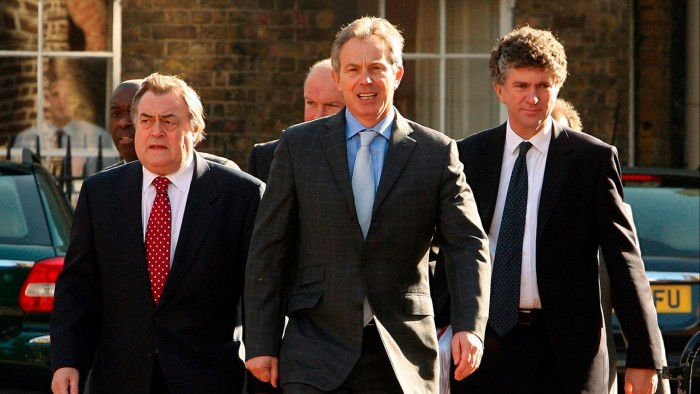This article is an on-site version of our Inside Politics newsletter. Subscribers can sign up here to get the newsletter delivered every weekday. If you’re not a subscriber, you can still receive the newsletter free for 30 days
Good morning. As I mentioned yesterday, I re-read Jonathan Powell’s The New Machiavelli on a recent trip.
I promise that I won’t do reflections on my holiday reading every day, but for today, some more on a stray observation in the book by Tony Blair’s former chief of staff.
Inside Politics is edited by Georgina Quach. Follow Stephen on Bluesky and X, and Georgina on Bluesky. Read the previous edition of the newsletter here. Please send gossip, thoughts and feedback to insidepolitics@ft.com
Which shape will Starmer take?
One thing Powell reflects on is that Margaret Thatcher’s popularity had a very different curve to Tony Blair’s:
Mrs Thatcher’s governments would start the parliament popular, then go through a trough of unpopularity as she tried to undertake difficult reforms, and finally come back up the other side of the U to win a further term. Being at the bottom of the U was nerve-racking for Tory politicians, but they were able to hold on, at least until the 1990 trough.
When we won in 1997, I thought we would have a similar trajectory, but instead the government’s popularity actually rose in the course of 1997 and only slowly declined over the following decade. So from 1997 to 2007, we experienced a long, slow, but seemingly inexorable slide into unpopularity.
The striking thing about these two shapes — the “U” bend of midterm unpopularity giving way to electoral success at the end of the parliament, and the declining gradient giving way to defeat — is that they are, broadly speaking, the pattern we see throughout most Conservative governments and most Labour ones respectively. Anthony Eden, Harold Macmillan, John Major, David Cameron and Boris Johnson all led their Conservative parties to victory having trailed midterm (though, with the exception of David Cameron, all of them took over trailing parties and revitalised them).
The Labour governments of Clement Attlee and Jim Callaghan experienced a slow decline that they never really got out of, with only Harold Wilson’s short first term in 1964-66 having the same “U” shape. And although, of course, Tony Blair maintained his government’s support for much longer than any of his Labour predecessors, New Labour had the same downward gradient as the Old Labour governments did.
Now, I’m not saying that Labour is barred from ever enjoying that U-shaped recovery, and that it is only reserved to Conservative governments.
But what I am saying is that the Labour party doesn’t really have any institutional memory or cultural history of coming back from trailing in the polls in the middle of the parliament to winning, other than what I would call the unusual circumstances of 1966. “1966” doesn’t really exist in the Labour mind as a comeback story, in any case.
One thing that complicates Labour’s hopes of doing anything internally controversial over the next four years is that large numbers of MPs think they are going to be one-termers and are therefore thinking of their own legacies and reputations. If the government wants to do anything that runs against the instincts of Labour MPs, one thing that will have to happen is that MPs will have to start to believe that this government is one in a U curve, not in the familiar downward gradient.
Now try this
On holiday I also read Colson Whitehead’s Sag Harbor, a lovely short novel about a teenager attempting to reinvent themselves, not particularly successfully.
On the politics front, I recently turned to some terrific new non-fiction by Philip Cowley, Chris Bryant, Tim Franks, Nick Gibb and Robert Peal.
Top stories today
-
‘Devastating’ | Several business leaders said they were “horrified” by Labour’s record in office so far. The government is working to repair relations with executives at Labour’s annual conference in Liverpool next month, followed by a UK regional investment summit in Birmingham in October. How did Labour get here?
-
Farage clarifies migration plan | Nigel Farage said Reform UK’s deportation plan would not include women and children within its first five years. It came as he announced the defection of a Conservative MSP to Reform.
-
Stay together for the kids | Britain’s EU relations minister has described plans to create a cross-channel youth mobility scheme as a “fantastic opportunity”, in a sign of the government’s growing confidence in rebuilding ties with Europe.
-
Budget on the mind | The Treasury is considering a tax increase for landlords in an attempt to boost revenue by targeting “unearned income” in Rachel Reeves’ budget, hears Aubrey Allegretti at the Times. Officials are examining proposals for applying national insurance to rental income in the hope of raising £2bn. The idea was proposed last September in the run-up to Reeves’ first budget by the Resolution Foundation.
-
Shake up | Keir Starmer is replacing the top civil servant in his Downing Street office, the BBC reports. Principal private secretary Nin Pandit runs the prime minister’s team at Number 10 and has only been in the role for 10 months. She is the third senior aide the prime minister has appointed and later let go, after chief of staff Sue Gray left in October and director of communications Matthew Doyle stood down in March.





1 Comment
6rw4fs